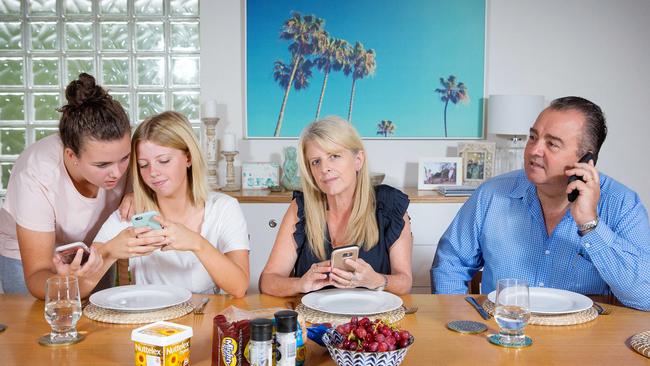Mobile phone addiction: Statistics reveal which groups use their phones the most
PHONE users are spending up to six hours a day glued to their screens — and it’s not young people who are the most addicted. As smartphone apps are “literally hacking the brain”, here’s how you can cut back.

VIC News
Don't miss out on the headlines from VIC News. Followed categories will be added to My News.
PHONE-addicted Aussies are spending up to six hours a day glued to their devices amid fears they are sacrificing quality time with their loved ones.
New research provided to the Sunday Herald Sun shows some smartphone users unlocking their devices an astounding 216 times a day — equal to once every three minutes over 12 hours.
The average Australian spends nearly 2½ hours a day on their mobile phone, with women aged 56-65 the worst offenders.
The figures provided by smartphone usage tracker AntiSocial show our phone addiction ranks among the highest worldwide. Only Russian, British and American users are hooked more.
Chris Eade, from tech firm Bugbean which developed AntiSocial, said most phone users underestimated their usage and were shocked to learn the reality.
“When you look at the data it’s crazy to see how much time we spend and what we do on our phones,” Mr Eade said.
AUSTRALIAN PARENTS STRUGGLING TO SET SMARTPHONE RULES AND LOBBYISTS SAY APPLE SHOULD HELP THEM

AUSTRALIANS’ GROWING SOCIAL MEDIA ADDICTION CONCERNS MENTAL HEALTH EXPERTS
The statistics — based on the phone usage of more than 130,000 AntiSocial users over two years — point to a worrying pattern of compulsive checking and social media use, according to experts.
Australians are launching mobile applications an average 101 times a day, with people aged 18-25 averaging 118 launches daily.
One AntiSocial user averaged 341 launches a day — opening Instagram 89 times and Snapchat on 103 occasions.
Social media apps take up the majority of Aussie users’ phone time with Facebook accounting for 20 per cent of total time spent “in app”.
Dating applications averaged 40 daily launches, Mr Eade said.
University of Wollongong internet addiction expert Prof Katina Michael said technology companies were engineering applications to make them as addictive as possible.
“They are literally hacking the brain — the content is turning to brainwashing,” she said.
“We can even see physical signs on highly addicted users, things like bruises on thumbs and index fingers from excessive swiping. It (addiction) can happen to anyone, at any time.”
The University of Adelaide’s Daniel King, a specialist in behavioural addiction, said it was important not to paint addiction as black and white.
“An addictive disorder relates to a person’s ability to control their time spent and whether or not it’s impacting function,” he said.
“It’s not obvious that just using your phone is addictive, though it can facilitate addictive behaviours.”
IF YOU’RE A SMARTPHONE JUNKIE, THIS iPhone CASE RATIONS YOUR SCREEN TIME

For those who think they have a problem, Mr Eade recommended leaving the phone off for the first and last 30 minutes of the day and tracking daily usage to self-regulate.
Turning social media notifications off or removing apps for extended periods of time could also help people feel less anxious about their phones. Mr Eade said: “More important is what you’re doing on your phone. We all need our phones, but things like aimlessly scrolling social media just isn’t productive.”
Beaumaris mum Robyn Svojtka and her two daughters enjoy quality family time but admit mobile phones sometimes get in the way.
“I use my phone for absolutely everything,” Mrs Svojtka said.
“We use it for talking, texting, online banking, social media, work, WhatsApp — everything.
“It’s a vital form of communication. I’ve got teenage daughters who are going to parties and friends’ houses — they’re independent. If I’m not contactable, I can feel nervous.”
Mrs Svojtka said her biggest concern about phone usage in her family was her daughters missing out on opportunities to learn and excel in other areas of life because they were focused on their devices.
“They waste a lot of time looking at things that don’t matter, that they could spend on things like guitar practice. It bothers me a lot.’’
HOW TO GET YOUR LIFE BACK
• Don’t use your phone for the first 30 minutes of your day, or the last 30 minutes
• If there was important news to be heard, a friend would call you, so no need to check social media endlessly
• Be real, don’t use social media when with friends, and engage and live in the real world
• Put your phone on silent during meals and put it somewhere so you aren’t tempted to look at it
• Turn off notifications from social media and turn off distractions
• Put your phone on silent during meals and put it somewhere so you aren’t tempted to look at it
• Try to have a phone-free morning once a week
• Delete social media apps from your phone and see how long you last. Be brave, you can do it!
• Leave your phone in another room for one hour per day — you won’t actually miss anything
BY THE NUMBERS
WORST AGE GROUP FOR DAILY PHONE USE
Women aged 56-65 2:35:08 hours
Men aged 14-17 2:24:49 hours
AGE GROUP WITH HIGHEST DAILY UNLOCKS
Women aged 18-25 40.14 unlocks
Men aged 18-25 43.12 unlocks
HOW AUSTRALIA’S DAILY PHONE USE RANKS WITH WORLD’S TOP USERS
Men
1 USA 2:37:17 hours
2 Russia 2:32:01 hours
3 Canada 2:26:54 hours
4 UK 2:24:02 hours
5 Australia 2:14:58 hours
Women
1 USA 2:54:06 hours
2 UK 2:37:16 hours
3 Australia 2:29:59 hours
4 Canada 2:29:58 hours
5 Russia 2:14:10 hours
APP LAUNCHES A DAY
Aged 14-17 95.17 times
Aged 18-25 118.73 times
Aged 26-35 105.35 times
Aged 36-45 85.4 times
Aged 46-55 87.42 times
Aged 56-55 63.67 times
Aged 66-75 51.91 times
Source: AntiSocial
AUTISM-LIKE SYMPTOMS SHOWING UP
SMARTPHONES are changing the way our brains work.
Emerging research suggests excessive mobile phone use can rewire neural pathways, increase anxiety and mimic the symptoms of autism and obsessive compulsive disorder.
Professor Katina Michael, from the University of Wollongong, has been researching phone and internet addiction for more than 20 years. She said obsessive compulsive-like behaviour on phones was having an enormous impact on society, particularly in younger generations.
“We have a whole generation of kids unable to identify mood from facial expressions,” Prof Michael said. “Addictions to social media like Facebook can mimic symptoms of autism in adolescents.”
Prof Michael added that compulsive use of devices was hijacking the brain’s pleasure and reward centres.
“It creates an unending feedback loop in the brain,’’ she said. “The brain is never satisfied — no matter how many ‘likes’ you get or times you check your phone. That’s where the anxiety comes from.”
Phones could also have an effect even when not in use.
A University of Chicago study found negative cognitive effects of mobile phone use remained even when the phone was off but nearby. Prof Michael said children needed classroom lessons on the addictive qualities of smartphones.


